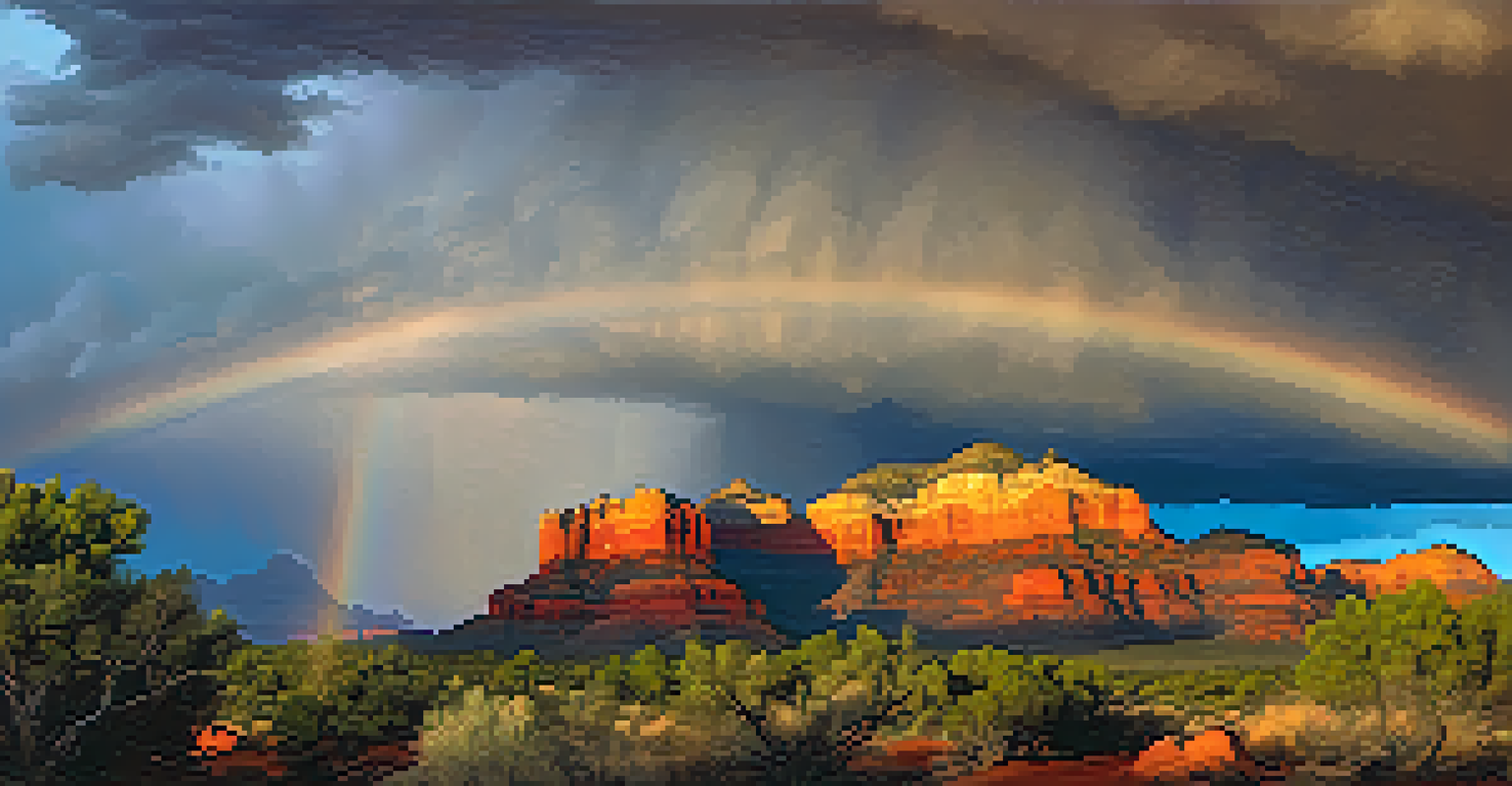The Role of Sedona's Geography in Weather Patterns

Sedona's Unique Topography Shapes Its Climate
Sedona is renowned for its breathtaking red rock formations and diverse topography, which significantly influence its climate. The elevation of around 4,500 feet means that temperatures can vary greatly, creating microclimates within the region. For instance, the cooler temperatures at higher elevations contrast with the warmer valleys, leading to varied weather experiences in close proximity.
The clearest way into the Universe is through a forest wilderness.
This unique topography also causes interesting weather phenomena, such as localized thunderstorms. When warm air rises over the mountains, it can cool rapidly, resulting in rain showers that might not reach lower areas. Thus, the geography of Sedona creates a dynamic interplay between different weather conditions, making it a fascinating place for meteorological study.
Additionally, the presence of the Verde Valley to the north and the surrounding Coconino National Forest adds to the complexity of Sedona's weather. These geographical features can block or redirect prevailing winds, further shaping the local climate. Overall, Sedona's topography is a crucial factor in understanding its weather patterns.
The Influence of Elevation on Temperature Variability
Elevation plays a critical role in Sedona's temperature fluctuations throughout the year. The higher you go, the cooler it generally becomes, which can be quite surprising for visitors expecting a consistent desert climate. For example, while the valley might bask in the sun at 90°F, the peaks could be a cool 70°F, creating an inviting escape from the summer heat.

This significant difference in temperature can also affect local vegetation and wildlife. Higher elevations often support pine forests and diverse flora that are less common in the lower desert areas, creating distinct ecosystems. As a result, the variation in temperature due to elevation fosters a rich biodiversity that contributes to Sedona's natural beauty.
Unique Topography Influences Climate
Sedona's varied elevations and red rock formations create distinct microclimates and weather patterns throughout the region.
Moreover, these temperature variations can lead to distinct seasonal changes, where winter snows can blanket the higher elevations while the valley remains relatively dry. This contrast not only enriches the landscape but also affects activities such as hiking and outdoor recreation, making Sedona a year-round destination for nature enthusiasts.
How Sedona's Geography Affects Precipitation Patterns
Sedona's geography contributes significantly to its precipitation patterns, which can be quite variable. The area receives most of its rainfall during the monsoon season, typically from July to September, when moisture-laden air moves in from the Gulf of California. However, the topography causes some areas to receive more rain than others, leading to a patchwork of dry and lush regions.
In every walk with nature one receives far more than he seeks.
For instance, the red rock formations can create rain shadows, where certain areas receive little to no precipitation while others nearby may experience heavy rain. This phenomenon not only affects local agriculture but also shapes the ecosystem, influencing which plants and animals thrive in various parts of Sedona.
Additionally, the unpredictable nature of rainfall can lead to sudden flash floods, particularly in canyons and dry washes. This can pose risks for hikers and outdoor enthusiasts but also contributes to the stunning landscape that defines Sedona, as the rain rejuvenates the earth and enhances the vibrant colors of the rock formations.
The Role of Winds in Sedona's Weather Dynamics
Winds are another crucial element in Sedona's weather dynamics, influenced by the surrounding mountains and valleys. These winds can shift suddenly, impacting temperature and precipitation patterns. For instance, gusty winds can push warm air up the canyon walls, creating conditions ripe for thunderstorms, particularly in the summer months.
Moreover, the direction of the winds can dictate the type of weather that Sedona experiences. Winds coming from the west often bring moisture from the Pacific Ocean, while those from the east can be much drier, leading to stark contrasts in weather conditions. Understanding these wind patterns is essential for predicting Sedona's daily weather changes.
Elevation Affects Temperature Variability
The significant temperature differences between Sedona's valleys and peaks contribute to diverse ecosystems and seasonal changes.
Ultimately, the interplay of these winds with the region's topography makes Sedona's weather dynamic and often unpredictable. This complexity adds to the allure of Sedona, as residents and visitors alike are treated to a constantly evolving landscape shaped by the winds.
Microclimates: A Closer Look at Sedona's Weather Variability
Microclimates are small, localized weather patterns that exist within a larger climate zone, and Sedona is a prime example of this phenomenon. Due to its varied elevation, rock formations, and vegetation, different areas can experience significantly different weather conditions. For instance, while one part of Sedona may be sunny and warm, a nearby area could be cooler and shaded.
These microclimates can create unique environments for various plant and animal species, fostering a rich biodiversity. Certain plants that require cooler, wetter conditions may thrive in shaded canyons, while others that enjoy full sun flourish on exposed cliffs. This variety not only enhances the ecological richness of Sedona but also offers diverse recreational opportunities for nature lovers.
Understanding these microclimates is vital for outdoor activities, such as hiking or photography. Knowing where to find the best conditions can significantly enhance the experience, allowing visitors to witness the stunning contrasts in Sedona's natural beauty. Thus, microclimates play a crucial role in the overall charm of this captivating region.
Seasonal Changes and Their Impact on Sedona's Geography
Seasonal changes in Sedona profoundly affect its geography and weather patterns. Each season brings a unique character to the landscape, from the vibrant blooms of spring to the stunning fall foliage. Winter can cover the higher elevations with a blanket of snow, creating an enchanting atmosphere that attracts winter sports enthusiasts.
These seasonal shifts also influence local wildlife, as animals adapt their behaviors and habitats according to the changing weather. For example, many species migrate to lower elevations during winter months, while others may take advantage of the cooler temperatures in the summer. This seasonal rhythm adds a dynamic layer to the ecosystem, making Sedona a living portrait of nature's cycles.
Winds Shape Sedona's Weather Dynamics
The interplay of winds with Sedona's geography results in dynamic weather conditions, influencing everything from precipitation to temperature.
Moreover, the changing seasons affect recreational activities as well. Summer is popular for hiking and exploring the canyons, while fall draws visitors for the breathtaking autumn colors. Each season offers a different experience, allowing residents and tourists to engage with Sedona's geography in a multitude of ways throughout the year.
Conclusion: Sedona's Geography and Its Intriguing Weather Patterns
In conclusion, Sedona's geography plays a pivotal role in shaping its weather patterns, creating a tapestry of diverse climates and experiences. From its unique topography and varying elevations to the influence of winds and microclimates, each element contributes to the region's dynamic weather. Understanding these geographical factors not only enhances our appreciation for Sedona's natural beauty but also informs our interactions with this stunning environment.
As visitors explore the breathtaking landscapes, they can witness firsthand the interplay of geography and weather. Whether it's enjoying a sunny hike in the valley or experiencing a sudden rain shower in the canyons, Sedona offers a rich tapestry of weather experiences that are as captivating as its red rock formations.

Ultimately, Sedona stands as a testament to the intricate relationship between geography and weather, inviting all to marvel at the beauty and complexity of nature. As we continue to explore and understand this remarkable region, we gain insights into the delicate balance that defines Sedona's enchanting climate.